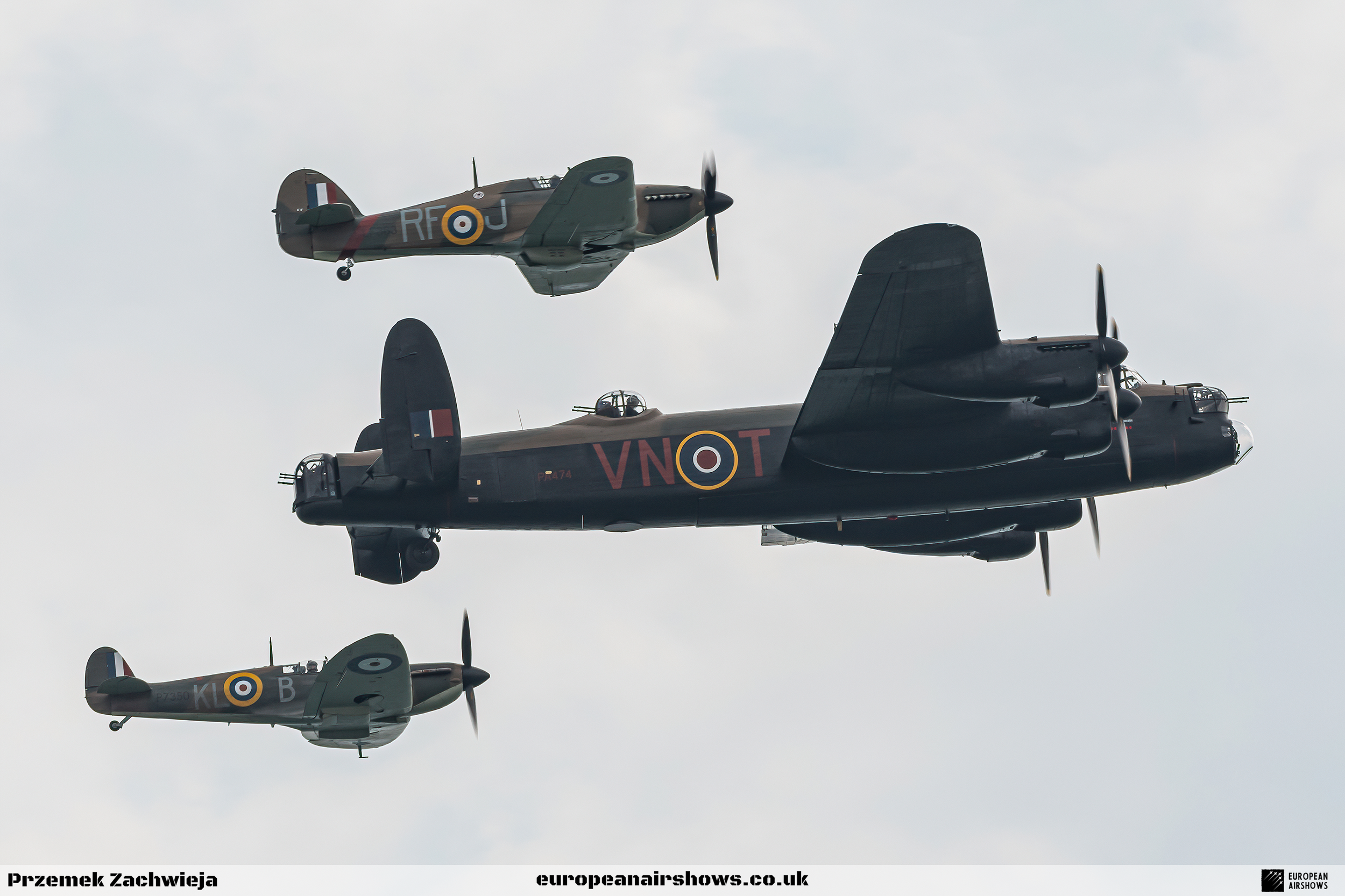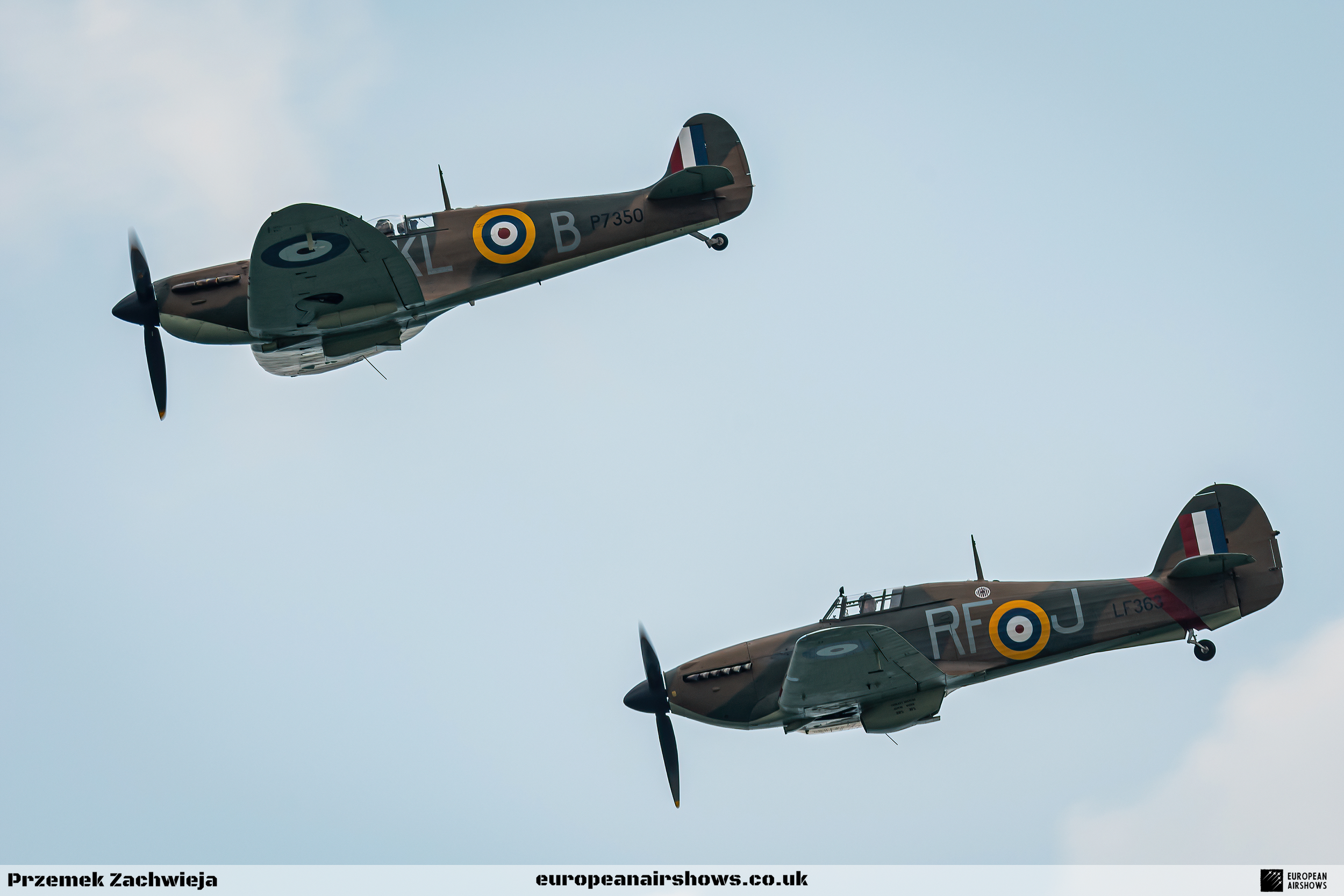
Hawker Hurricane LF363
About the Hawker Hurricane
The Hawker Hurricane, a British single-seat fighter aircraft of the 1930s and 1940s, was a cornerstone of the Royal Air Force (RAF) during World War II, though it often lived in the shadow of the more glamorous Supermarine Spitfire. Designed and predominantly built by Hawker Aircraft Ltd., the Hurricane was a rugged and versatile aircraft that played a pivotal role in all major theaters of the war. Its most iconic contribution came during the Battle of Britain in 1940, where it inflicted 60% of the losses sustained by the German Luftwaffe, proving its effectiveness against enemy aircraft. Despite being slower than the Spitfire and the Messerschmitt Bf 109, the Hurricane's tight turning ability, robust construction, and ease of maintenance made it a formidable opponent and a reliable workhorse for the RAF.
The Hurricane's story began in the early 1930s, stemming from discussions between RAF officials and aircraft designer Sir Sydney Camm about creating a monoplane derivative of the Hawker Fury biplane. At the time, the Air Ministry was reluctant to embrace monoplanes, favoring traditional biplanes, but Hawker persisted with the design. The Hurricane incorporated several innovations crucial to wartime fighters, including retractable landing gear and the powerful Rolls-Royce Merlin engine. The prototype, K5083, took its maiden flight on 6 November 1935, and after successful trials, the aircraft entered squadron service in December 1937. Its conventional construction methods made it easier to produce and repair, a significant advantage as war loomed. By September 1939, the RAF had 18 Hurricane-equipped squadrons, and over 14,000 units were eventually built, including versions produced in Canada, Belgium, and Yugoslavia.
Throughout World War II, the Hurricane was adapted into various roles, showcasing its versatility. It served as a bomber-interceptor, fighter-bomber, and ground support aircraft, with variants like the Sea Hurricane designed for naval operations featuring modifications such as an arrestor hook for ship-based use. The Hurricane saw extensive action in the Phoney War, the Battle of France, and the defense of Malta, where it faced intense Luftwaffe attacks. In the Soviet Union, under the Lend-Lease program, the Hurricane was the first Allied aircraft delivered, though Soviet pilots had mixed opinions about its performance compared to German and Soviet fighters. In the Battle of Britain, it was often tasked with engaging German bombers while Spitfires tackled fighters, leveraging its strengths as a stable gun platform. Its simplicity also allowed it to be flown by less experienced pilots, a critical factor as the RAF expanded rapidly during the war.
The Hurricane's operational history is marked by its reliability and adaptability, but also by its challenges. Despite being slower than the Spitfire and the Bf 109, its rugged construction and tight turning ability made it effective, especially at lower altitudes. However, it had vulnerabilities, such as fuel tanks susceptible to catching fire, which led to serious pilot injuries. To address this, Air Vice Marshal Hugh Dowding ordered the retrofitting of Linatex, a self-expanding rubber coating, to seal punctured tanks. By the end of the war, the Hurricane had been largely replaced by more advanced fighters like the Hawker Typhoon, but its legacy remained significant. It played a key role in the Allied victory, particularly in the early years when the outcome of the war was uncertain, and saw action in diverse theaters, from North Africa to the Soviet Union and Southeast Asia.
The Hawker Hurricane's story is one of innovation, resilience, and quiet heroism, embodying the spirit of the RAF during one of history's most challenging conflicts. Often overshadowed by the Spitfire, its impact on the war effort was undeniable, with its contributions during the Battle of Britain and beyond cementing its place in history. From its early development in the face of institutional skepticism to its widespread production and deployment, the Hurricane proved that simplicity and reliability could triumph in the face of adversity. Its legacy endures as a testament to the ingenuity of its designers and the bravery of the pilots who flew it, making it a true unsung hero of World War II.
Specifications
Crew
1
Length
32 ft 3 in (9.83 m)
Wingspan
45 ft 6 in (13.87 m)
Height
40 ft 0 in (12.19 m)
Max Speed
340 mph (550 km/h, 300 kn)
Range
600 mi (970 km, 520 nmi)
Service Ceiling
36,000 ft (11,000 m)
Rate of climb
2,780 ft/min (14.1 m/s)
Hurricane Mk.IIc Variant
The Hurricane Mk.IIc was a pivotal variant in the evolution of the Hawker Hurricane, marking a significant upgrade in firepower and operational capability. Introduced during the critical days of the Battle of Britain in September 1940, the Mk.IIc was distinguished by its armament of four 20 mm Hispano Mk II cannons, a substantial improvement over the earlier machine gun configurations. This change was driven by the need to counter increasingly armored enemy aircraft, particularly the Luftwaffe's bombers and fighters. Powered by the Rolls-Royce Merlin XX engine, which featured a two-speed supercharger, the Mk.IIc offered enhanced performance at various altitudes, making it more versatile in combat scenarios. The Merlin XX engine, with its improved supercharger, allowed the Hurricane to maintain competitiveness against newer German aircraft, especially at medium and high altitudes.
Beyond its role as a day fighter, the Hurricane Mk.IIc proved adaptable to multiple combat roles, including night fighting and intruder missions. Its cannons made it particularly effective against bombers, and it was often employed in ground-attack roles, where its firepower could be directed against enemy vehicles and installations. The variant's versatility was further demonstrated in its deployment across various theaters of war, from the defense of Malta to the deserts of North Africa. In Malta, the Hurricane Mk.IIc played a crucial role in fending off Axis air raids, while in North Africa, it was used extensively for ground support, attacking enemy armor and supply lines. The aircraft's rugged design and ease of maintenance made it well-suited for these demanding environments, where operational readiness was critical.
Production of the Hurricane Mk.IIc was substantial, with 4,751 units built by Hawker between February 1941 and July 1944, underscoring its importance to the Allied war effort. Despite being gradually overshadowed by more advanced fighters like the Supermarine Spitfire and the Hawker Typhoon, the Mk.IIc remained in service until the later stages of the war, particularly in secondary theaters and in roles where its specific capabilities were still valuable. Its legacy is one of adaptability and reliability, embodying the Hurricane's reputation as a workhorse of the Royal Air Force. The Mk.IIc's contributions, from the skies over Britain to the battlefields of Africa and beyond, cemented its place in aviation history as a key player in the Allied victory.
Did You Know?
- The Hawker Hurricane's design originated from discussions about creating a monoplane derivative of the Hawker Fury biplane in the early 1930s. Despite initial resistance from the Air Ministry, which preferred biplanes, Hawker persisted, incorporating innovations like retractable landing gear and the powerful Rolls-Royce Merlin engine, making it a significant leap forward in fighter design.
- The Hurricane was significantly easier and quicker to produce than its contemporary, the Supermarine Spitfire, requiring 10,300 man-hours per airframe compared to 15,200 for the Spitfire. Its conventional construction methods, using steel-tube structures and fabric covering, allowed squadrons to perform major repairs without external support, enhancing its wartime utility.
- The Hurricane was adapted into numerous variants, including bomber-interceptors, fighter-bombers, ground support aircraft, and the Sea Hurricane for naval operations. The Sea Hurricane, equipped with an arrestor hook, was crucial for carrier-based missions, while the Mk IID variant, armed with 40mm cannons, was nicknamed "Flying Can Openers" for its anti-tank capabilities.
- Beyond Britain, the Hurricane was manufactured in Canada, Belgium, and Yugoslavia. Notably, Canadian Car and Foundry produced 1,451 Hurricanes, with their chief engineer Elsie MacGill earning the nickname "Queen of the Hurricanes" for her contributions. This international production expanded the aircraft's global reach during World War II.
- The Hurricane saw action in multiple theaters, including the Battle of France, defense of Malta, North Africa, the Soviet Union under the Lend-Lease program, and the Pacific theater in Singapore and Java. It inflicted 60% of the Luftwaffe's losses during the Battle of Britain, proving its critical role despite being overshadowed by the Spitfire in public perception.
Test Your Knowledge
Hurricane LF363
In the latter part of 1943, as World War II raged across the globe, the Hawker Aircraft factory in Langley, near Slough in Berkshire, was a hive of activity, churning out machines to bolster the Allied war effort. Among these was a cannon-armed Mk IIC Hurricane, soon to be christened LF363. This particular aircraft rolled off the production line with little fanfare, but its story would prove to be anything but ordinary, weaving a tale of wartime service, a brush with oblivion, and a celebrated second life in the skies.
LF363’s journey began in earnest on a chilly New Year’s Day, January 1st, 1944, when it took to the air for its first flight—a routine air test that marked the start of its career with the Royal Air Force. As the war entered its final, grueling phases, this Hurricane found itself thrust into action, patrolling the rugged east coast of Scotland. There, it flew missions to protect coastal shipping routes and conducted air defense patrols, ever watchful for enemy threats. Beyond these frontline roles, LF363 also pitched in with second-line duties, proving its versatility in the RAF’s sprawling wartime operations.
When peace finally arrived in 1945, the fate of many wartime aircraft hung in the balance, and LF363 was no exception. By 1948, it had been shipped back to its birthplace at Hawkers in Langley, likely earmarked for the scrap heap—a common end for surplus military planes in the post-war years. But this Hurricane’s story took a dramatic turn, thanks to a timely intervention. Air Vice-Marshal Sir Stanley Vincent CB DFC AFC, the Air Officer Commanding No 11 Group, stepped in, advocating for LF363’s preservation. His efforts, combined with those of other unsung heroes, snatched the aircraft from the jaws of destruction, setting it on a new path.
From 1949 to 1956, LF363 lived a somewhat rogue existence, cared for rather unofficially by a rotating cast of front-line squadrons and Station Flights. These units kept the Hurricane airworthy, not for combat but for ceremony. It soared above London each year, leading the Battle of Britain flypasts—stirring tributes to the pilots and planes that had turned the tide in 1940. These majestic displays ensured LF363 remained a familiar sight, its propellers cutting through the sky in honor of a hard-fought past.
The Hurricane’s tale reached a triumphant milestone in July 1957, following a major refit back at Hawkers. Freshly refurbished, LF363 rolled out as one of the founding aircraft of the RAF Historic Flight, a fledgling outfit inaugurated at Biggin Hill that would later evolve into the renowned Battle of Britain Memorial Flight (BBMF). This new role cemented its status as a living relic, a flying bridge between the wartime sacrifices of the 1940s and the generations that followed. Through grit, luck, and the passion of those who refused to let it fade, Hurricane LF363 transformed from a wartime workhorse into a cherished icon, its wings still beating the air in tribute to history.





